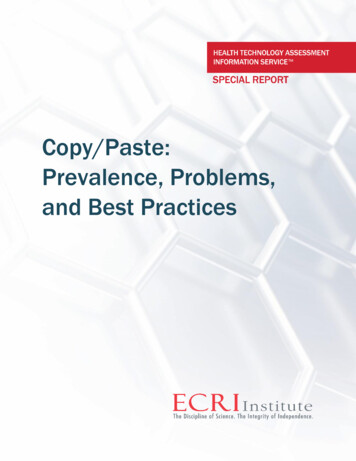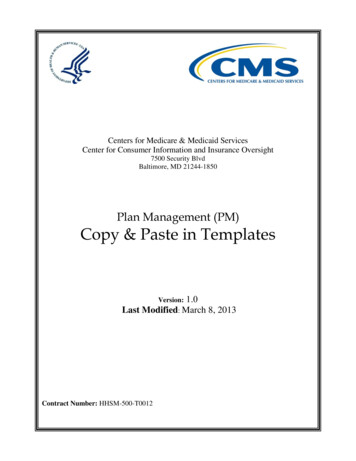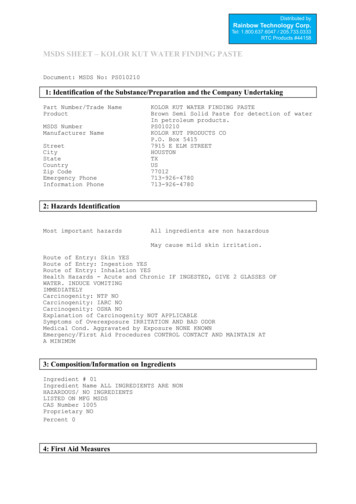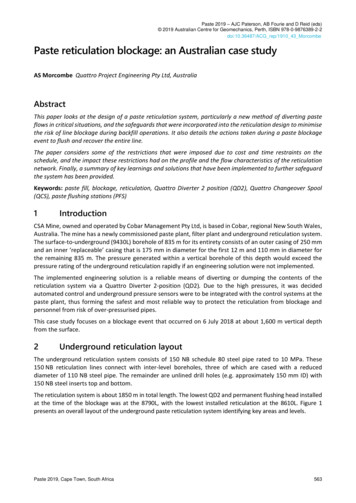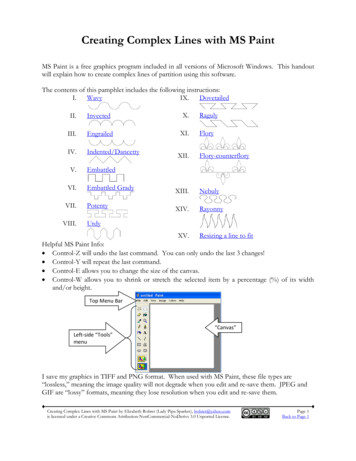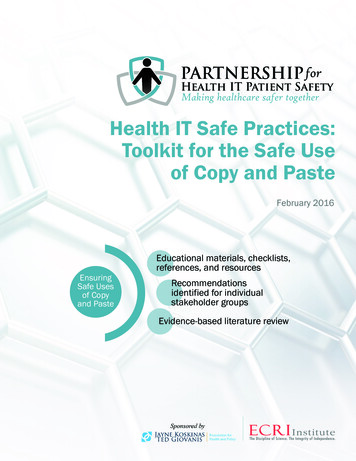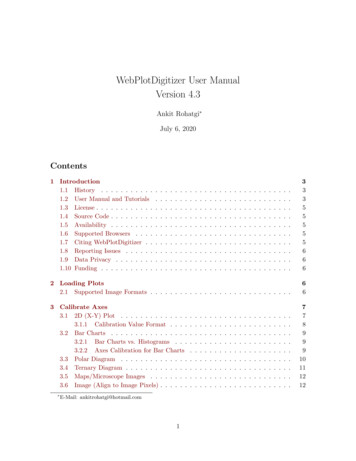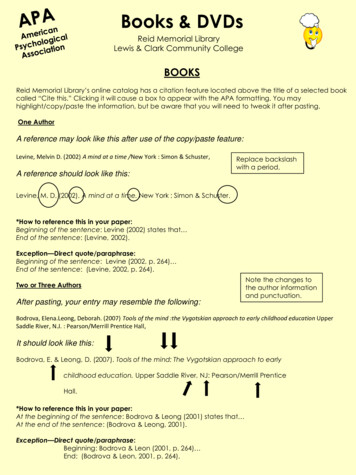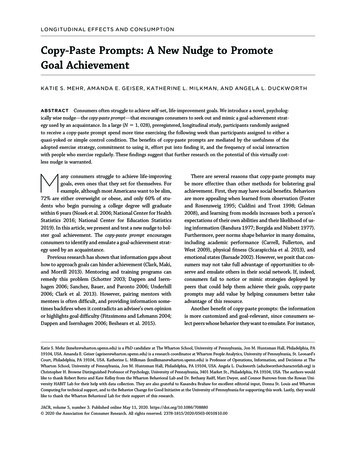
Transcription
LONGITUDINAL EFFECTS AND CONSUMPTIONCopy-Paste Prompts: A New Nudge to PromoteGoal AchievementK A T I E S . M E H R , A M A N DA E . G E I S E R , K A T H E R I N E L . M I L K M A N , A N D A N G E L A L . D U C K W O R T HAB STR ACT Consumers often struggle to achieve self-set, life-improvement goals. We introduce a novel, psychologically wise nudge—the copy-paste prompt—that encourages consumers to seek out and mimic a goal-achievement strategy used by an acquaintance. In a large (N 5 1; 028), preregistered, longitudinal study, participants randomly assignedto receive a copy-paste prompt spend more time exercising the following week than participants assigned to either aquasi-yoked or simple control condition. The benefits of copy-paste prompts are mediated by the usefulness of theadopted exercise strategy, commitment to using it, effort put into finding it, and the frequency of social interactionwith people who exercise regularly. These findings suggest that further research on the potential of this virtually costless nudge is warranted.Many consumers struggle to achieve life-improvinggoals, even ones that they set for themselves. Forexample, although most Americans want to be slim,72% are either overweight or obese, and only 60% of students who begin pursuing a college degree will graduatewithin 6 years (Nosek et al. 2006; National Center for HealthStatistics 2016; National Center for Education Statistics2019). In this article, we present and test a new nudge to bolster goal achievement. The copy-paste prompt encouragesconsumers to identify and emulate a goal-achievement strategy used by an acquaintance.Previous research has shown that information gaps abouthow to approach goals can hinder achievement (Clark, Maki,and Morrill 2013). Mentoring and training programs canremedy this problem (Schotter 2003; Dappen and Isernhagen 2006; Sanchez, Bauer, and Paronto 2006; Underhill2006; Clark et al. 2013). However, pairing mentors withmentees is often difficult, and providing information sometimes backfires when it contradicts an advisee’s own opinionor highlights goal difficulty (Fitzsimons and Lehmann 2004;Dappen and Isernhagen 2006; Beshears et al. 2015).There are several reasons that copy-paste prompts maybe more effective than other methods for bolstering goalachievement. First, they may have social benefits. Behaviorsare more appealing when learned from observation (Fosterand Rosenzweig 1995; Cialdini and Trost 1998; Gelman2008), and learning from models increases both a person’sexpectations of their own abilities and their likelihood of using information (Bandura 1977; Borgida and Nisbett 1977).Furthermore, peer norms shape behavior in many domains,including academic performance (Carrell, Fullerton, andWest 2009), physical fitness (Scarapicchia et al. 2013), andemotional states (Barsade 2002). However, we posit that consumers may not take full advantage of opportunities to observe and emulate others in their social network. If, indeed,consumers fail to notice or mimic strategies deployed bypeers that could help them achieve their goals, copy-pasteprompts may add value by helping consumers better takeadvantage of this resource.Another benefit of copy-paste prompts: the informationis more customized and goal-relevant, since consumers select peers whose behavior they want to emulate. For instance,Katie S. Mehr (kmehr@wharton.upenn.edu) is a PhD candidate at The Wharton School, University of Pennsylvania, Jon M. Huntsman Hall, Philadelphia, PA19104, USA. Amanda E. Geiser (ageiser@wharton.upenn.edu) is a research coordinator at Wharton People Analytics, University of Pennsylvania, St. Leonard’sCourt, Philadelphia, PA 19104, USA. Katherine L. Milkman (kmilkman@wharton.upenn.edu) is Professor of Operations, Information, and Decisions at TheWharton School, University of Pennsylvania, Jon M. Huntsman Hall, Philadelphia, PA 19104, USA. Angela L. Duckworth (aduckworth@characterlab.org) isChristopher H. Browne Distinguished Professor of Psychology, University of Pennsylvania, 3401 Market St., Philadelphia, PA 19104, USA. The authors wouldlike to thank Robert Botto and Kate Kelley from the Wharton Behavioral Lab and Dr. Bethany Raiff, Matt Dwyer, and Connor Burrows from the Rowan University HABIT Lab for their help with data collection. They are also grateful to Kasandra Brabaw for excellent editorial input, Donna St. Louis and WhartonComputing for technical support, and to the Behavior Change for Good Initiative at the University of Pennsylvania for supporting this work. Lastly, they wouldlike to thank the Wharton Behavioral Lab for their support of this research.JACR, volume 5, number 3. Published online May 11, 2020. https://doi.org/10.1086/708880 2020 the Association for Consumer Research. All rights reserved. 2378-1815/2020/0503-0010 10.00
330Copy-Paste PromptsMehr et al.a consumer who wants to run more regularly can ask foradvice from a peer who runs a lot rather than one who frequently goes to yoga class. Because consumers value designing and customizing products (Franke, Schreier, and Kaiser2010), they may be more likely to adopt a customizable strategy obtained via a copy-paste prompt.Finally, copy-paste prompts may increase perceived autonomy. People prefer self-made products and evaluate themmore positively (Troye and Supphellen 2012; Dohle, Rall,and Siegrist 2014). Feelings of autonomy can also increasethe perceived value of a creative experience (Dahl and Moreau 2007). Thus, actively searching for information themselves may lead consumers to value it more than if theyhad received the same advice passively.In a large (N 5 1; 028), preregistered longitudinal experiment (https://aspredicted.org/kh2w7.pdf), we tested whethercopy-paste prompts could increase the amount of time spentexercising among those hoping to work out more, and wefound that they indeed did. We included two control conditions in our experiment: one in which participants receivedan exercise strategy found by someone else using a copypaste prompt in a prior study (a quasi-yoked control) andone in which no strategy was provided (a simple control).All participants were asked about their intended exercisestrategies in order to hold constant the formation of implementation intentions across conditions (Gollwitzer 1999).Our appendix (available online) includes three earlier studies showing that copy-paste prompts add value. We foundthat copy-paste prompts improved exercise outcomes morethan providing top-rated exercise hacks (study A1) orprompting study participants to find and mimic an unrelated strategy—in this case, a fashion strategy (study A2).Copy-paste prompts also increased students’ preparednessfor class more than being prompted to seek out and tellfriends an unrelated fun fact (study A3).Unexpectedly, attrition from our control conditions(19.85% in our simple control, 17.87% in our quasi-yokedcontrol) was higher than in our copy-paste prompt condition(11.41%; simple control vs. copy-paste: x2 (1) 5 10:36,p 5 :001, quasi-yoked control vs. copy-paste: x2 (1) 5 6:30,p 5 :012). Because our copy-paste prompt condition hadless attrition and participants on the margin of completinga study are typically the least motivated, our differentialattrition should actually bias us against finding a differencebetween conditions, making our study a particularly conservative test of our hypothesis. Notably, this pattern of differential attrition also suggests our copy-paste prompt conditionincreased an unanticipated measure of participants’ motivation to achieve their goals: their rate of completing our study.METHODOn the following screens, they were told that this hackshould be something they did not already know but applicable to their lives.In the quasi-yoked control condition, participants readthe following:ParticipantsUsing Amazon’s Mechanical Turk (MTurk), we recruited1,230 participants who reported that they wanted to exercise more. Following our preregistered analysis plan, weexcluded data from 161 individuals who failed to answerboth dependent variable questions, 37 individuals who completed our surveys more than once, and 4 individuals whofailed an attention-check quiz in our first survey. Our finalsample consisted of N 5 1; 028 individuals (58.56% female,mean age 5 38:30 years).Design and ProcedureParticipants completed three surveys over the course of10 days. They earned 0.05 per survey and 10 if all threesurveys were completed.Figure 1 depicts the flow of our experiment. First, participants were asked how many hours they spent exercising inthe last week and were randomly assigned to one of threeconditions: the copy-paste prompt condition, the quasiyoked control condition, or the simple control condition.All participants then read information about the bonus payment structure.Next, in the copy-paste prompt condition, participantsread the following:In this study, we want to help you learn about an effective hack or strategy that someone you know usesas motivation to exercise. Over the next 2 days, we’dlike you to pay attention to how people you know getthemselves to work out. If you want, you can ask themdirectly for their motivational tips and strategies.In this study, we’re hoping to help you learn aboutan effective hack or strategy that motivates peopleto exercise. Over the next 2 days, we’d like you toget ready to learn a new strategy to motivate you toexercise.
Volume 5Number 32020331Figure 1. Survey design and what information was provided to participants in each condition in each survey.Next, in both the copy-paste prompt and quasi-yokedcontrol conditions, participants completed a brief comprehension quiz, which they were required to pass within threetries to continue in the study. Finally, participants in all experimental conditions answered demographic questionsand were reminded of the 10 bonus payment they wouldreceive if they completed all three study surveys over thenext 10 days.Two days later, all participants were sent the same reminder messages to complete our second survey. In all conditions, participants described strategies that they woulduse in the next week to exercise more. In addition to describing strategies, participants in the copy-paste promptcondition summarized the strategy they planned to copypaste from an acquaintance. In the quasi-yoked controlcondition, participants were provided with one of 358 exercise strategies (selected at random) that another participant had copy-pasted in a previous study (e.g., “For everyhour that you exercise, allow yourself 15 minutes on socialmedia”).1 In addition to describing strategies, these participants summarized the strategy they had just received fromthe experimenter. Finally, all participants were reminded thatthey needed to complete a final survey in a week to earn 10.A week after completing our second survey (and 10 daysafter the start of the study), all participants were reminded1. A week before conducting this experiment, we ran a pilot test of400 different participants on Amazon’s MTurk. The purpose of this pilotwas to collect strategies that could be given to participants in the quasiyoked control condition of our main experiment.
332Copy-Paste PromptsMehr et al.to complete our final survey. Participants in all conditionswere asked how many hours they had spent exercising inthe past week (a drop-down menu allowed them to giveanswers ranging from “0” to “25 or more hours,” in half-hourincrements) and how motivated they felt to exercise (ona 5-point scale ranging from 1 5 “not at all motivated”to 5 5 “extremely motivated”). Participants’ responses tothese questions were our primary, preregistered dependentvariables.Participants then answered nine additional questionsdesigned to explore why copy-paste prompts may be effective. Using a 7-point scale ranging from “not at all” to “extremely,” participants indicated how useful, new, customized, or appealing they found the strategies they used toexercise more over the past week, how committed they wereto using these strategies, how much effort they put intofinding them, how much feedback they received about them,how often they socialized with people who exercised a lot,and how many conversations they had about exercising. Finally, participants were invited to upload a screenshot oftheir step count over the past week for a 1 bonus. Complete experimental stimuli are available in the appendix,and all data and analyses are available online (https://osf.io/drwvh/).RESULTS AND DISCUSSIONUnfortunately, only 124 participants (12.06%) submittedscreenshots of their step count during our study, so we focused on our primary preregistered outcomes (self-reportedexercise and motivation) and included analyses of these limited step count data by condition in our appendix.2 We did,however, find a significant, positive correlation betweennumber of steps taken and self-reported time spent exercising (r 5 :298, p 5 :0008), lending support to the validity ofour self-reported exercise measure in the full sample.To determine if copy-paste prompts increased time spentexercising relative to the control conditions, we conducteda linear regression in which our primary predictors werean indicator for assignment to our copy-paste prompt condition and an indicator for assignment to our quasi-yoked control condition. We also included controls for participants’age, gender, and self-reported time spent exercising the2. Those select participants who shared step count data with us didwalk directionally (but insignificantly) more total steps over the courseof our entire 10-day study in the copy-paste prompt condition than inother conditions.week before the experiment began (collected before randomassignment in survey 1). As shown in table 1, model 1, participants in the copy-paste prompt condition spent significantly more time exercising (M 5 4:32, standard deviation(SD) 5 3:44) than those in the simple control condition(M 5 3:37, SD 5 2:75; p :0001). We also found that participants in our copy-paste prompt condition spent significantly more time exercising than those in our quasi-yokedcontrol condition (M 5 3:64, SD 5 2:47; p 5 :003). OnTable 1. Impact of a Copy-Paste Prompts on ExerciseOutcomesDependent variableCopy-paste prompt conditionQuasi-yoked controlTime spent exercising weekbefore experiment beganAgeFemaleWald test: Difference in meansof copy-paste and quasi-yokedcontrol conditions, standarderror of differencesObservationsR2Time spentexercisingZ-scoredmotivationto exerciseModel 1Model 3521,028.120Note.— This table reports coefficient estimates from two ordinaryleast squares regressions estimating the impact of a copy-pasteprompt on z-scored self-reported motivation to exercise and timespent exercising. Model 1 estimates the effect of the copy-pasteprompt and quasi-yoked control condition on z-scored self-reportedmotivation to exercise, controlling for time spent exercising beforethe experiment began, age, and gender. Model 2 regresses the sameindependent variables on self-reported time spent exercising. Waldtests compare the effect of the copy-paste prompt to a quasi-yokedcontrol. Standard errors are reported in parentheses.* p 5 5% level.** p 5 1% level.*** p 5 .1% level.
Volume 5average, during our 1-week follow-up period, the regressionestimated impact of copy-paste prompts was 55.8 and 32.5more minutes spent exercising than those in our simple control and quasi-yoked control conditions, respectively. We alsofound that men benefited more than women from receivinga copy-paste prompt (p 5 :018; see the appendix for moreinformation).As shown in table 1, model 2, participants in our copypaste prompt condition reported feeling significantly moremotivated to exercise (M 5 3:42, SD 5 1:13) than participants in our simple control condition (M 5 3:10, SD 51:18; p 5 :0001) but only directionally more motivatedto exercise than participants in our quasi-yoked controlcondition (M 5 3:28, SD 5 1:10; p 5 :189).In preregistered exploratory analyses, we examined possible mechanisms for the effect of the copy-paste prompton time spent exercising. We conducted a bootstrapped multiple mediation analysis, comparing the copy-paste promptcondition to the quasi-yoked control condition. We foundthat the usefulness of the exercise strategy (b 5 :218, 95%confidence interval ½CI 5 ½:069; :385 ), commitment to using the exercise strategy (b 5 :196, 95% CI 5 ½:080; :349 ),effort put into finding the exercise strategy (b 5 :147, 95%CI 5 ½:016; :283 ), and social interactions with people whoexercise regularly (b 5 :089, 95% CI 5 ½:010; :205 ) all mediated the relationship between the copy-paste prompt condition and reported time spent exercising. In the appendix,we include separate mediation models for each potentialmediator measured that are consistent with this multiplemediation model.GENERAL DISCUSSIONIn a large, longitudinal, preregistered study of exercise behavior, we found that a brief and virtually costless copypaste prompt improved goal-directed outcomes over the following week. Specifically, this nudge led to greater increasesin the amount of time spent exercising than did passively receiving a strategy of similar quality, highlighting the valueof actively finding goal-related strategies among one’s peers.Exploratory mediation analyses suggested that autonomy,the opportunity to identify personally useful strategies, increased commitment to self-identified solutions, and positivepeer influence all played a role in making copy-paste promptseffective. Taken together with our three studies in the appendix, we showed that copy-paste prompts routinely outperform control conditions.While these early results are promising, our work has anumber of important limitations. First, although we soughtNumber 32020333to collect an objectively measured dependent variable, onlya very small and nonrepresentative subgroup shared verifiable information on their behavior. Our self-reported measure of time spent exercising was highly correlated withobjectively measured steps in this select subsample, butfurther research with objective measures of behavior areneeded to confirm the benefits of copy-paste prompts. Second, there was differential attrition across conditions inour primary study. While the observed attrition—higherin the control groups than in the copy-paste group—actually implies that we conducted a conservative test of ourhypothesis, and this problem was not present in other studies reported in our appendix (see studies A1 and A3), itwould be ideal to replicate our findings without any attrition. Third, further research investigating why copy-pasteprompts helped men more than women in our study wouldbe useful. Finally, our 10-day study did not examine thelong-term impact of copy-paste prompts. It would be valuable to conduct a study with a longer follow-up period.In spite of these limitations, our findings suggest copypaste prompts may be a valuable new policy tool. They areeasy to implement, virtually costless, and widely applicablewith the potential to improve outcomes ranging from healthyeating to academic success. Furthermore, it may be that oncea consumer learns to copy-paste in one domain (e.g., exercise), she will be able to apply this technique in a way thatimproves many other outcomes (e.g., retirement savings).REFERENCESBandura, Albert (1977), “Social Learning Theory,” in Social Learning Theory,Englewood Cliffs, NJ: Prentice-Hall, 1–46.Barsade, Sigal G. (2002), “The Ripple Effect: Emotional Contagion and ItsInfluence on Group Behavior,” Administrative Science Quarterly, 47 (4),644–75.Beshears, John, James J. Choi, David Laibson, Brigitte C. Madrian, andKatherine L. Milkman (2015), “The Effect of Providing Peer Information on Retirement Savings Decisions,” Journal of Finance, 70 (3), 1161–201.Borgida, Eugene, and Richard E. Nisbett (1977), “The Differential Impactof Abstract vs. Concrete Information on Decisions,” Journal of AppliedSocial Psychology, 7 (3), 258–71.Carrell, Scott E., Richard L. Fullerton, and James E. West (2009), “DoesYour Cohort Matter? Measuring Peer Effects in College Achievement,”Journal of Labor Economics, 27 (3), 439–64.Cialdini, Robert B., and Melanie R. Trost (1998), “Social Influence: SocialNorms, Conformity and Compliance,” in The Handbook of Social Psychology, Vol. 1, ed. Daniel T. Gilbert, Susan T. Fiske, and GardenrLindzey, New York: McGraw-Hill, 151–92.Clark, Robert L., Jennifer A. Maki, and Melinda Sandler Morrill (2013),“Can Simple Informational Nudges Increase Employee Participationin a 401(k) Plan?” Southern Economic Journal, 80 (3), 677–701.
334Copy-Paste PromptsMehr et al.Dahl, Darren W., and C. Page Moreau (2007), “Thinking Inside the Box:Why Consumers Enjoy Constrained Creative Experiences,” Journal ofMarketing Research, 44 (3), 357–69.Dappen, Leon, and Jody C. Isernhagen (2006), “Urban and NonurbanSchools: Examination of a Statewide Student Mentoring Program,” Urban Education, 41 (2), 151–68.Dohle, Simone, Sina Rall, and Michael Siegrist (2014), “I Cooked It Myself:Preparing Food Increases Liking and Consumption,” Food Quality andPreference, 33 (April), 14–16.Fitzsimons, Gavan J., and Donald R. Lehmann (2004), “Reactance to Recommendations: When Unsolicited Advice Yields Contrary Responses,”Marketing Science, 23 (1), 82–94.Foster, Andrew D., and Mark R. Rosenweig (1995), “Learning by Doingand Learning from Others: Human Capital and Technical Change inAgriculture,” Journal of Political Economy, 103 (6), 1176–209.Franke, Nikolaus, Martin Schreier, and Ulrike Kaiser (2010), “The ‘I Designed It Myself’ Effect in Mass Customization,” Management Science,56 (1), 125–40.Gelman, Susan A. (2008), “Learning from Others: Children’s Constructionof Concepts,” Annual Review of Psychology, 60 (1), 115–40.Gollwitzer, Peter M. (1999), “Implementation Intentions: Strong Effectsof Simple Plans,” American Psychologist, 54 (7), 493–503.National Center for Education Statistics (2019), “Graduation Rate fromFirst Institution Attended for First-Time, Full-Time Bachelor’s Degree-Seeking Students at 4-year Postsecondary Institutions, by Race/Ethnicity, Time to Completion, Sex, Control of Institution, and Acceptance Rate: Selected Cohort Entry Years, 1996 through 2011,” 8 326.10.asp.National Center for Health Statistics (2016), “Obesity and sity-overweight.htm.Nosek, Marlene B., Lenny R. Vartanian, Brian A. Nosek, and Kelly D.Brownell (2006), “The Influence of One’s Own Body Weight on Implicitand Explicit Anti-Fat Bias,” Obesity, 14 (3), 440–47.Sanchez, Rudolph J., Talya N. Bauer, and Matthew E. Paronto (2006),“Peer-Mentoring Freshmen: Implications for Satisfaction, Commitment, and Retention to Graduation,” Academy of Management Learningand Education, 5 (1), 25–37.Scarapicchia, Tanya M., Catherine M. Sabiston, Ross E. Andersen, andEnrique Garcia Bengoechea (2013), “The Motivational Effects of SocialContagion on Exercise Participation in Young Female Adults,” Journalof Sport and Exercise Psychology, 35 (6), 563–75.Schotter, Andrew (2003), “Decision Making with Naive Advice,” AmericanEconomic Review, 93 (2), 196–201.Troye, Sigurd V., and Magne Supphellen (2012), “Consumer Participationin Coproduction: ‘I Made It Myself” Effects on Consumers’ SensoryPerceptions and Evaluations of Outcome and Input Product,” Journalof Marketing, 76 (2), 33–46.Underhill, Christina M. (2006), “The Effectiveness of Mentoring Programsin Corporate Settings: A Meta-Analytical Review of the Literature,”Journal of Vocational Behavior, 68 (2), 292–307.
Goal Achievement KATIE S. MEHR, AMANDA E. GEISER, KATHERINE L. MILKMAN, AND ANGELA L. DUCKWORTH ABSTRACT Consumers often struggle to achieve self-set, life-improvement goals. We introduce a novel, psycholog-ically wisenudge—the copy-paste prompt—thatencourages consumers toseekout andmimic agoal-achievement strat-egyused by anacquaintance.

